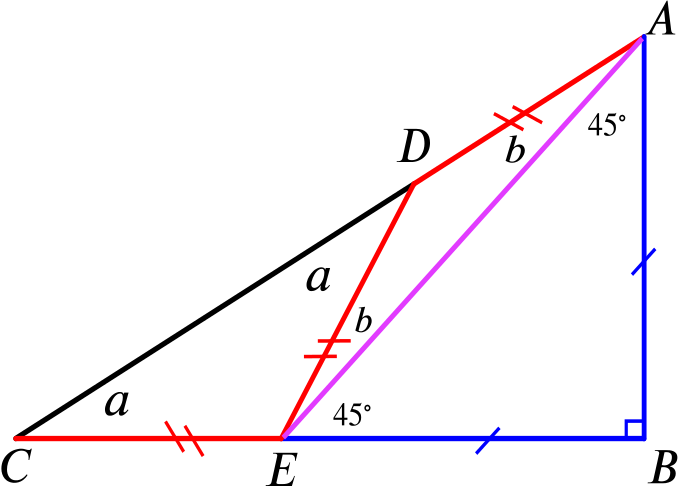- Without using tables, show for \(\theta=15^\circ\) that \(\sin\theta=\dfrac{\sqrt{6}-\sqrt{2}}{4}\), and find the values of \(\cos\theta\) and \(\tan\theta\).
and so, since \(\cos \theta\) is positive between \(0^\circ\) and \(90^\circ\), \[\cos 15^\circ=\frac{\sqrt{6}+\sqrt{2}}{4}.\]
Finally, we have \[\begin{align*} \tan 15^\circ=\frac{\sin15^\circ}{\cos15^\circ} &=\frac{\sqrt{6}-\sqrt{2}}{\sqrt{6}+\sqrt{2}} \\ &=\frac{(\sqrt{6}-\sqrt{2})^2}{(\sqrt{6}+\sqrt{2})(\sqrt{6}-\sqrt{2})} \\ &=\frac{6+2-2\sqrt{2}\sqrt{6}}{6-2} \\ &=\frac{8-2\sqrt{12}}{4} \\ &=2-\sqrt{3}. \end{align*}\]- In the triangle \(ABC\), \(B\) is a right angle and the other angles are such that if a point \(E\) on \(BC\) and between \(B\) and \(C\) is chosen so that \(BE=BA\), then there is a point \(D\) on \(AC\) and between \(A\) and \(C\) such that \(AD=DE=EC\). Find the ratio of \(DC\) to \(AB\).
First let’s draw what’s happening, filling in the angles by putting in \(a\) for \(ACB\) and \(b\) for \(CAE\).

The angle-sum in triangle \(ABC\) tells us that \(a+b = 45^\circ\). The angle at \(D\) tells us that \(a = 2b\). Solving these equations simultaneously gives \(b = 15^\circ, a = 30^\circ\).
We need the ratio of \(DC\) to \(AB\). Without loss of generality we can put \(CE = 1\), so \(CD = 2 \cos 30^\circ\) and \(EA = 2\cos 15^\circ\).
Now, by Pythagoras, \(AB = \dfrac{2\cos 15^\circ}{\sqrt{2}}\).
Thus \[\begin{align*} DC:AB &= 2\cos 30^\circ: \dfrac{2\cos 15^\circ}{\sqrt{2}}\\ &= \sqrt{3} : \sqrt{2}\frac{\sqrt{6}+\sqrt{2}}{4} \\ &= 4\sqrt{3} : \sqrt{12}+2 \\ &=2\sqrt{3} : \sqrt{3}+1. \end{align*}\]
